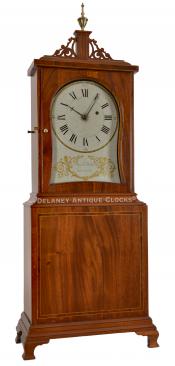Aaron Willard Massachusetts Shelf clock. Boston. 223025.
This Massachusetts Shelf Clock was made by Aaron Willard of Boston, Massachusetts, circa 1810. The case is constructed in mahogany, mahogany veneers, holey inlays, and New England white pine.
Aaron Willard was born in Grafton, Massachusetts, on October 13, 1757. Little is known of his early life in Grafton. He probably learned the skill of clock-making from his older brothers Benjamin and Simon. It is recorded that he did march with them in response to the Lexington Alarm on April 19, 1775. In 1780, Aaron moved from Grafton to Roxbury with his brother Simon. Here the two Willard brothers establish a reputation for themselves as fine clock manufacturers. They were both responsible for training a large number of apprentices, many of whom became famous clockmakers in their own right. The Willards dominated the clock-making industry in the Boston area during the first half of the nineteenth century. Aaron worked in a separate location in Roxbury from his brother and relocated about a quarter mile away from Simon’s shop across the Boston line about 1792. Aaron is listed in the 1798 Boston directory as a clock maker “on the Neck,” and his large shop employed up to 30 people, while 21 other clock makers, cabinetmakers, dial and ornamental painters, and gilders worked within a quarter-mile radius by 1807. We have owned a large number of tall case clocks made by this important Maker. In addition, we have also owned a good number of wall timepieces in the form of banjo clocks and numerous Massachusetts shelf clock forms.
This clock stands on four applied ogee bracket feet. They are well formed and are applied to a double-step molding. The base panel features a richly-grained selection of mahogany framed with a double-line inlay pattern. The hood door frames the kidney-shaped dial. The inlay pattern used on the base is also used across the upper case molding. Above this is a molding that supports a large reeded plinth. It is fitted with an urn-shaped brass finial. A pierced fret-work pattern helps to decorate the top. This is a very successful detail. The dial is fitted to the case with a pine mask board.
The painted iron was manufactured and painted by Spencer Nolen in Boston. It features a time ring formatted with a gilt outer ring. Arabic quarter hour numerals are separated from the Roman-style hour numerals by minute markers. Below the time ring is a decorative area where one will find the Maker’s signature. The signature is boldly signed in a script format. The working location of “BOSTON” is presented in block lettering. The framed-in oval decoration is formed by applied or raised gesso designs that are highlighted with gilt paint. The time is indicated by the two hand-filed pierced arrow-formed steel hands.
The weight-powered time-only movement is constructed in brass. Steel shafts and polished steel pinions support the gearing. The escapement is a recoil format. This movement is designed to run for an eight-day duration and is of good quality.
This very good example was made circa 1810 and stands approximately 36.5 inches tall, 14.5 inches wide, and 6.5 inches deep.
Inventory number 223025.










